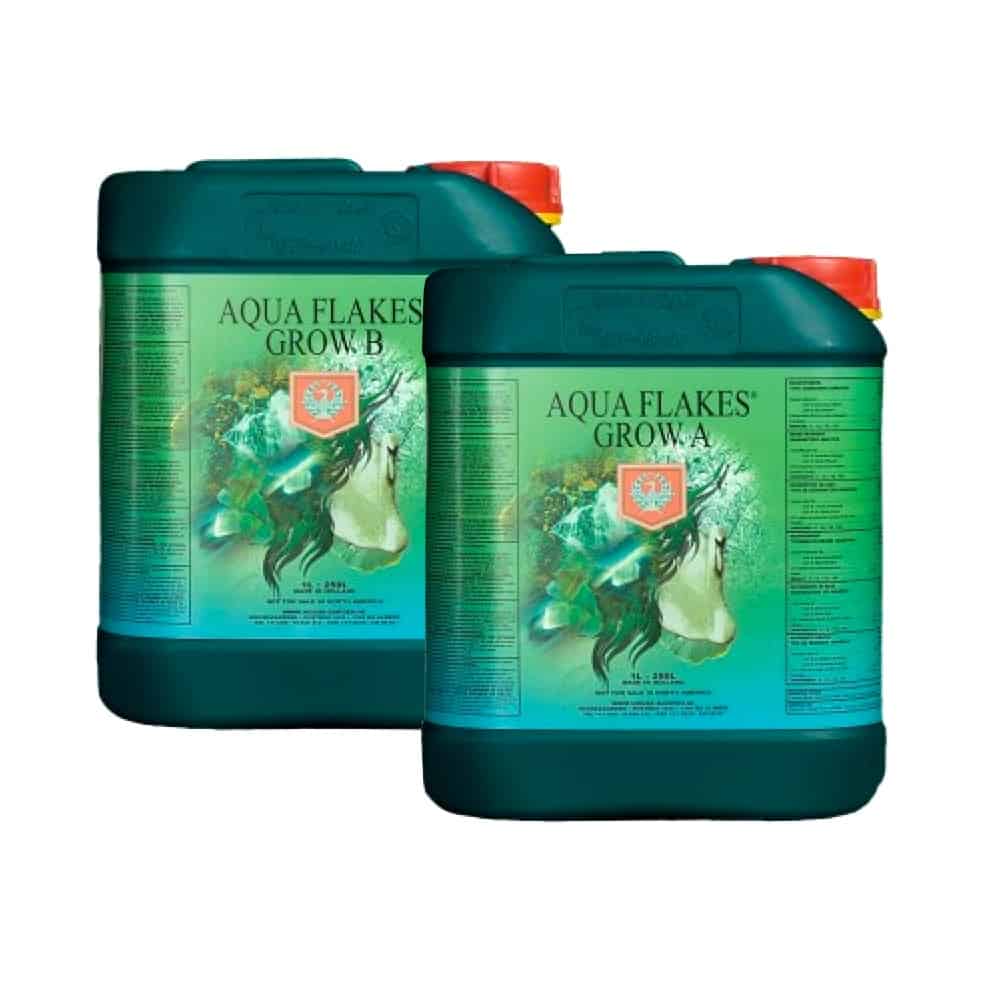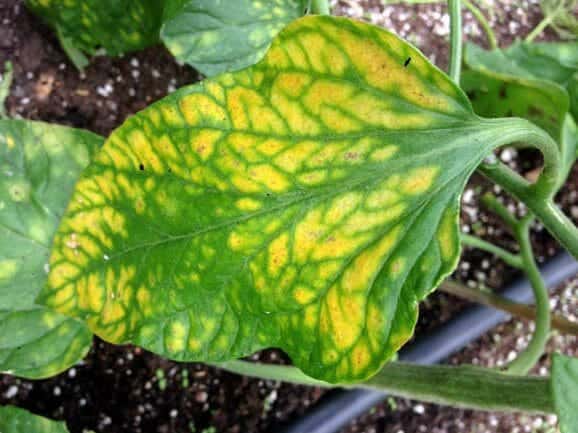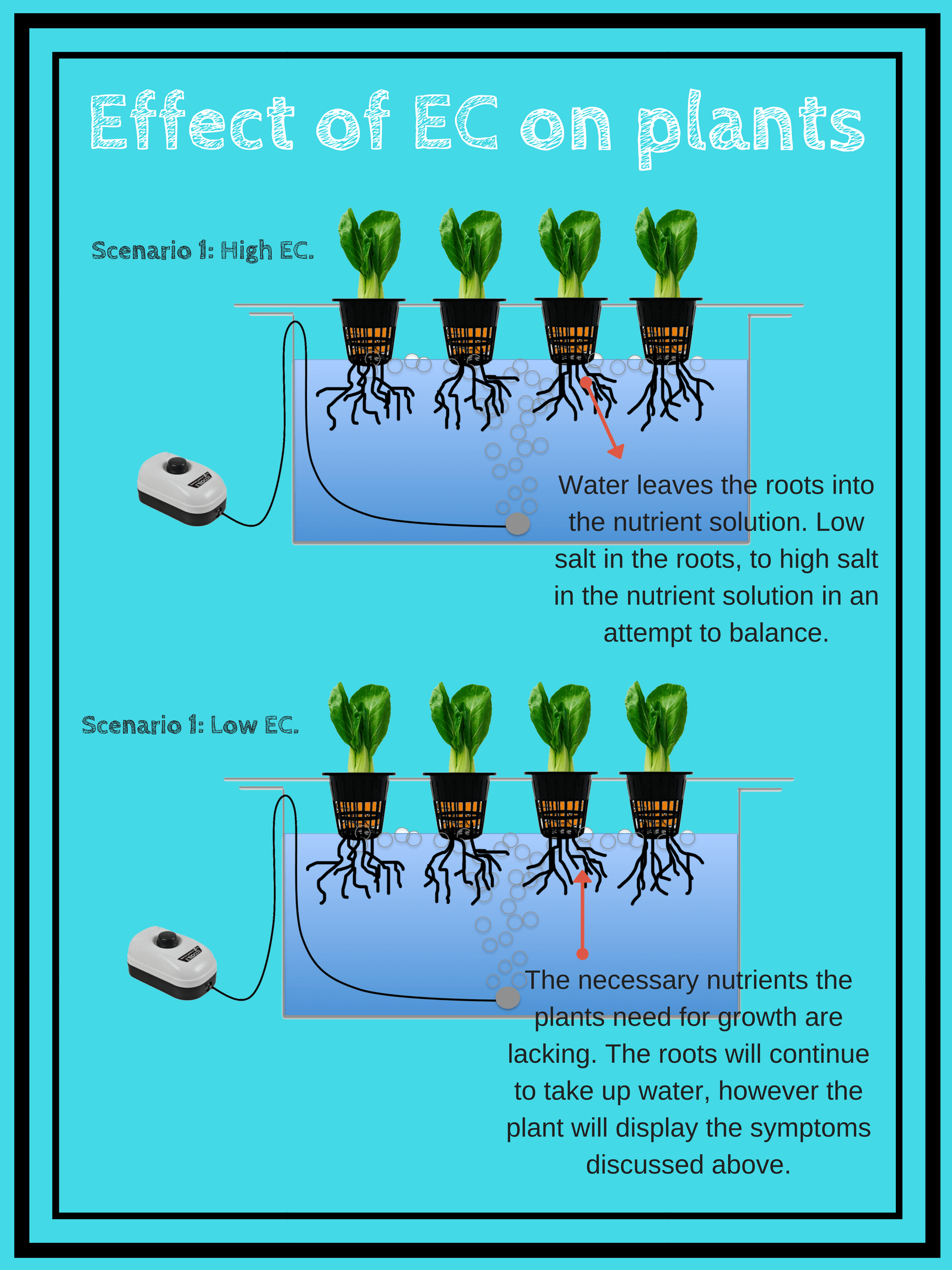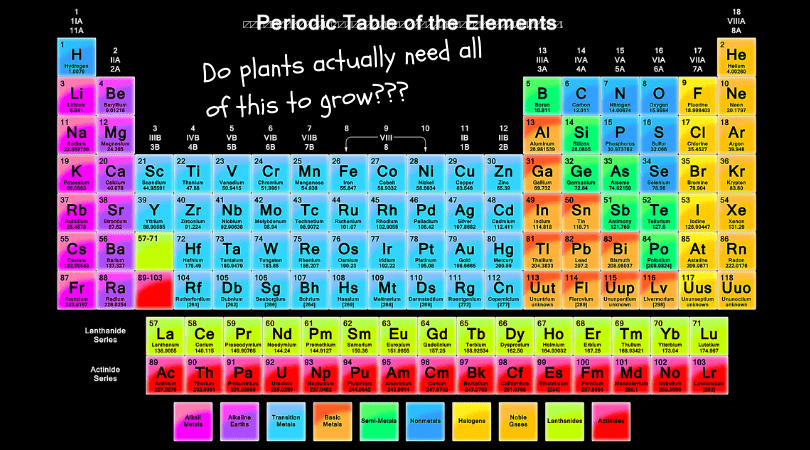All plants, whether grown indoors or outdoors, require the same nutrients to be healthy. Plants grown in a hydroponic system are no exception. The major difference, general hydroponic nutrients are supplied via the water system as opposed to in the soil.
As we work on our hydroponic gardens, it’s important to understand what nutrients we are supplying and what can go wrong. No matter which company you purchase your nutrient solution(s) from, there are several factors to keep in mind when setting up and maintaining your system.
- The composition of the nutrients- Does the solution contain all of the necessary elements required for plant growth, and are they at the proper ratios.
- The strength or ‘EC’ of the nutrient solution- What should the concentration of your nutrients be at each particular stage of plant growth. This is also dependent on the type of hydroponic system you are using. Finally, how is this measured.
What are the general hydroponic nutrients

The simplest way to start out is to buy a pre-mixed nutrient solution. At The Homestud, we use one from House & Garden, called Aqua flakes A+B. Learn about the concentrations we used in our DIY deep water culture build.
These pre-mixed solutions are diluted (when using liquid concentrates) in water before use. Powdered nutrients are dissolved in water before use. Similar to House & Gardens aqua flakes, most solutions come in 2,3, or even 4 ‘parts’ so gardeners can alter ratios depending on the stage of plant growth. For example, younger seedlings will require a different nutrient ratio compared to fruiting or flowering plants.
No matter what you do, make sure you choose one meant for hydroponic systems. Do not use any of the mixes sold as ‘indoor plant food’ like miracle grow. They are not meant to be a complete plant food, and only meant for supplementing plants in soil.
To be considered a complete plant food, a hydroponic nutrient solution needs to have the essential elements for plant growth. The essential nutrients required are:
Nitrogen (N) is essential for leaf and stem growth, as well as overall size and vigor.
Phosphorus (P) is necessary for photosynthesis, respiration, and energy storage.
Potassium (K) regulates the opening and closing of stomata during photosynthesis, regulating carbon dioxide uptake. It also triggers the activation of enzymes involved in sugar production, and is essential for the production of adenosine triphosphate (ATP, the energy source of plants).
Magnesium (Mg) is the essential building block of chlorophyll, the central molecule involved in the absorption of light.
Calcium (Ca) is essential to cell growth. It is one of the primary components responsible for holding cell walls together.
Sulfur (S) is used during protein production and amino acids synthesis. Sulfur also helps with resistance to disease and in seed formation.
Iron (Fe) is crucial to plant health, even if it is in tiny amounts. Iron is involved in chlorophyll production, allowing the plant to breath, while giving it the healthy green color.
Manganese (Mn) is critical to several plant processes including chloroplast formation, photosynthesis, nitrogen metabolism and enzyme production.
Zinc (Zn) is a key constituent of many enzymes and proteins. It plays an important role in growth hormone production and internode elongation.
Copper (Cu) activates some enzymes involved in lignin synthesis. It is also required during photosynthesis, plant respiration, and assists in the metabolism of carbohydrates and proteins.
Boron (B) is necessary for cell division and plant growth. It is also involved in cell wall formation and stability, as well as maintaining membrane structural integrity.
Molybdenum (Mb) is an essential component in two enzymes responsible for converting nitrate into nitrite (which is toxic), and then into ammonia before it is used to synthesize amino acids.
Chlorine (Cl) is involved in osmotic (salt) regulation across membranes, as well as disease resistance and tolerance.
The levels that these elements are present in your general hydroponic nutrients tend to vary between brands, since there is no one single recommendation for concentrations. This is part of the fun growing hydroponically, experiment and have fun.
These general hydroponic nutrients are needed regardless the hydroponic system you are using to grow. The only difference may be the concentration. Keep reading to learn more about these two very important factors.
General hydroponic nutrients: The problems
Whether you chose to buy a per-mixed nutrient solution, or you made your own from fertilizer salts, problems can still arise. The most common being deficiencies of one or more elements, ie. the nutrient strength is too low.

Signs of nutrient deficiency
Each of the mineral elements listed above are required by the plant. The difficult part is that deficiency of each element often presents a similar phenotype (characteristic). As a grower, learning to spot signs of deficiencies in general hydroponic nutrients can help you spot potential problems before they become severe. Below, I go through a brief discussion of how plants present when lacking any of the elements we have discussed. This is not meant to be an exhaustive list, as some signs can differ front plant to plant, as well as during different growth stages.
Nitrogen (N) – Plants exhibit poor growth, and the leaves are often a pale green to yellow color. This is due to an inability to synthesize enough chlorophyll.
Phosphorus (P) – This can be tricky to diagnose, and by the time a visual deficiency is noticed it may be too late. You MAY see stunted growth with a very dark green foliage. Cold temperatures can also negatively affect the uptake of phosphorus from the environment. Therefore, the problem may due to temperature and not a lack of phosphorus.
Potassium (K) – The leaves begin curling at the tips with brown scorching. You may also see yellowing (chlorosis) between leaf veins. Seed development is almost always reduced in potassium deficient plants.
Magnesium (Mg) – Plants lacking sufficient magnesium will begin to degrade chlorophyll in older leaves. This results in yellowing between leaf veins, giving the plant a variegated look.
Calcium (Ca) – This will initially appear as localized foliage necrosis (death), followed by stunted growth. Another common sign is necrotic young leaves or curling of the young leaves, ending with the death of buds and root tips.
Sulfur (S) – Deficiency in sulfur will result in pale green or yellowing foliage across the entire plant. However, this is not a common deficiency seen in hydroponics.
Iron (Fe) – A lack of iron is also called iron chlorosis, and starts with a yellowing of leaves in between the dark green veins. The leaf will often look like spider legs (pictured above). This is seen most commonly on the younger leaves, which helps distinguish it from magnesium deficiencies. Once again, cold temperatures can also impact iron’s uptake.
Manganese (Mn) – This often presents very similarly to iron deficiencies- yellowing of the leaves in between veins. At times, plants will also present with tan, or rust colored spots that appear between the leaf veins. Plants may also exhibit a stunted growth compared to healthy counterparts.
Zinc (Zn) – Once again, plants lacking zinc present with chlorosis- yellowing of the leaves between the veins.
Copper (Cu) – This is an easier problem to spot as plants deficient in copper will display dieback of the stems. You will also observe stunted growth, pale yellow leaves with ‘burnt’ spots that wither easily.
Boron (B) – This is the most widespread deficiency, causing reduced plant sizes from inhibited cell division. The plant will also display reduced fertility. The leaves eventually become thick, brittle, and potentially curled.
Molybdenum (Mb) – Leaves present with chlorosis- yellowing between the veins.
Chlorine (Cl) – Plants lacking chlorine display wilting leaves, that become yellow and necrotic. You may also notice a highly branched root system with stubby tips.
Measuring the strength of general hydroponic nutrients
If you are using a complete and balanced nutrient mix that provides all of the general hydroponic nutrients, then you are off to a good start. However, the next step is ensuring they are in the correct concentration. The wrong concentration of nutrients can have profound effects on plant growth and development.
This is why it’s essential to measure our general hydroponic nutrient concentration. It is best to measure using a meaningful unit. In the past parts per million (or ppm) was the standard, and was measured using TDS meters. However, there is now a movement to standardize the hydroponic industry by measuring the electrical conductivity (or EC). This is a more accurate measurement of your nutrient solution.
What does ppm measure, and what is a TDS meter?
Parts per million is exactly as it sounds. It is a measurement of the total parts (elements) per million. Something that is 1 ppm, is described as 1 milligram of something per liter of water, or 1 milligram of something per kilogram of soil.
A TDS meter measures Total Dissolved Solids in a solution. In our case water. Interestingly, a TDS meter actually measures the conductivity of a solution and then estimates the TDS from that reading. This is because dissolved ionized solids, such as salts and elements (our general hydroponic nutrients) increase the conductivity of the solution.
The problem with TDS meters is that the conversion is never really that accurate. This is why the industry is moving toward EC as the new unit of measurement.
What is EC actually measuring?
As I mentioned above, EC is a measure of electrical conductivity. Plant roots are actually responding to the osmotic concentration (number of salts in the solution). The specific number of salts in a solution will give off a specific EC. If we change the amount or even the ratio of salts, we change the osmolarity and the EC.
How do we measure EC?
In order to measure EC, we use EC (sometimes referred to as CF) meters. The easiest and most common type of meter used by hydroponic growers is the water-resistant pen type.
These units use either Microsiemens/cm (EC) or conductivity factor (CF). You may also see other units used or crop recommendations expressed as: Millimhos, micromhos, or millisiemens (mS). It is easy to convert between these units by shifting the decimal place.

Correcting setting up the EC for your general hydroponic nutrients depends on your particular plants, and your specific hydroponic system.
Crops like lettuce and other greens typically prefer a lower EC than flowering/fruiting crops such as tomatoes or peppers. More specifically each specific crop has an own ideal EC range for optimum growth.
The effect of EC
If you are more of a visual learner, take a look at this diagram that depicts how plants will react to a high or low EC:

In scenario 1, we see the EC is too high for the particular crop. This puts the plants under water stress. Water leaves the roots (more specifically the plant cells) into the more concentrated nutrient solution. Therefore when your general hydroponic nutrients are too concentrated, the first visible sign is plant wilting due to water loss. In simpler terms, water moves from inside the plant cells to the environment in an attempt to balance the salt concentration inside the cell with its environment.
In scenario 2, the EC is too low. Thus, we have a situation in which we will see nutrient deficiencies. In this case greater amounts of water are taken up in an attempt to balance the salt concentrations between the inside of the plant cell and the environment. The increased water uptake, with the lack of nutrients, will lead to a soft and floppy plant that may also display many of the symptoms discussed in the previous section.
Final thoughts
As hydroponic growers, we need to remain focused on the two most important factors of our nutrient solution- complete and balanced, as well as the concentration. When these are in perfect harmony, our general hydroponic nutrients will give maximum growth and yields. It is just as important when things go wrong to be able to quickly identify the problem and swiftly act before it becomes severe. Watching your plants closely is always your first line of defense.
Happy growing!


Everyone loves it whenever people come together and share ideas.
Great site, stick with it!